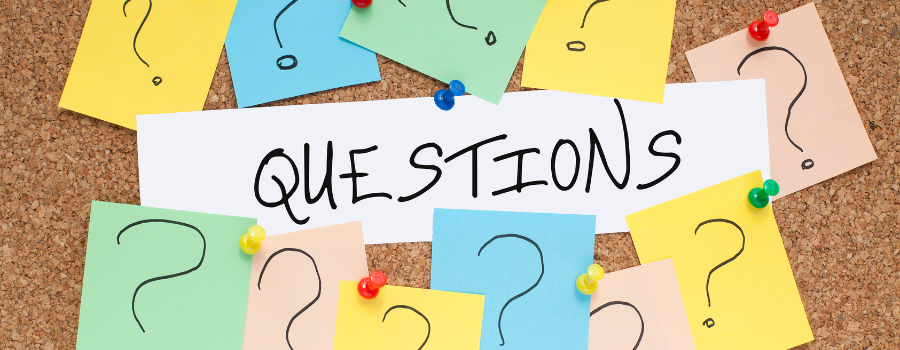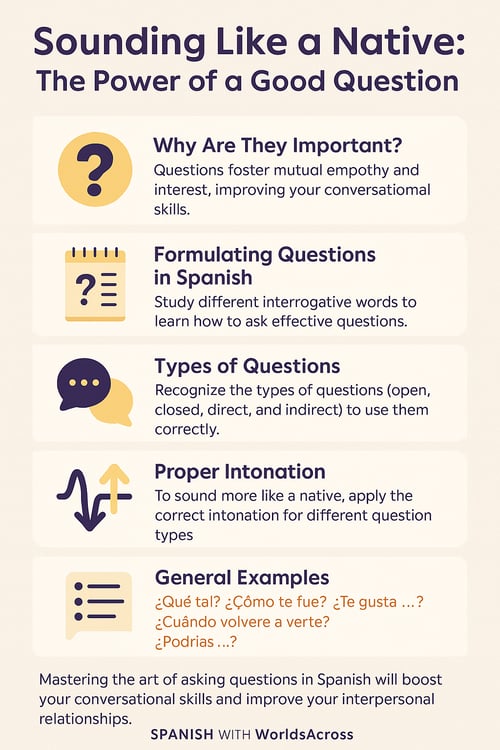Sounding Like a Native: The Power of a Good Question

Effective communication is one of the main goals for Spanish learners. However, achieving this goal requires mastering one of the most important components of a conversation: asking questions.
Knowing how to ask questions is essential for engaging in smooth and rewarding conversations. Moreover, good questions not only open the door to knowledge but are also an excellent tool for demonstrating empathy, interest, and respect toward others.
Keep reading! Throughout this article, you’ll learn how to ask questions in Spanish like a native. Don’t miss out!
Why Are They Important?
Questions are essential communication tools. Beyond merely acquiring information, good questions foster critical thinking, help identify problems, and kickstart the process of generating solutions.
Additionally, using questions properly during a conversation demonstrates mutual empathy and interest, creating collaborative environments through active participation. As a result, you’ll improve your conversational skills and develop higher-quality interpersonal relationships.
Formulating Questions in Spanish
Are you ready to communicate effectively? Study the following interrogative words; with them, it will be easier for you to learn how to ask questions correctly. Take note!
- Cuál: Used to make a distinction between two or more elements. Examples:
- ¿Cuál de las casas es la más bonita? / Which of the houses is the prettiest?
- ¿Cuál es tu carro? / Which is your car?
- Cuándo: Used to ask about time, whether in the past or future. Examples:
- ¿Cuándo vendrás a verme? (future) / When will you come to see me?
- ¿Cuándo compraste las entradas? (past) / When did you buy the tickets?
- Dónde: Used to ask for directions or the location of something/someone. Examples:
- ¿Dónde queda la iglesia? / Where is the church located?
- ¿Dónde está mi hermano/teléfono? / Where is my brother/phone?
- Cómo: Used to ask ‘in what way’ or ‘for what reason.’ Examples:
- ¿Cómo hiciste esa pirueta? / How did you do that trick?
- ¿Cómo sabes que estoy triste? / How do you know I’m sad?
- Quién: Used to ask about someone and/or their actions. Examples:
- ¿Quién es ella? / Who is she?
- ¿Quién se comió mi helado? / Who ate my ice cream?
- Por qué: Used to ask for reasons.
- ¿Por qué no me llamaste ayer? / Why didn’t you call me yesterday?
- ¿Por qué estudias español? / Why do you study Spanish?
- Qué: Used to ask for specific information. Examples:
- ¿Qué te dijo el profesor? / What did the teacher say to you?
- ¿Qué te pasa? / What’s wrong with you?
Now it’s your turn to practice! Memorize these interrogative words and create Spanish questions in the contexts of your choice.
Types of Questions
To achieve effective communication and boost your conversational skills, you must recognize the different types of questions and know which ones to use depending on the situation:
First, we have open-ended questions, which allow the respondent to express themselves freely. Examples:
- ¿Qué te pareció el concierto? / What did you think of the concert?
- ¿Por qué decidiste emprender? / Why did you decide to start a business?
On the other hand, closed-ended questions are limited to short and simple answers like ‘yes’ and ‘no.’ Examples:
- ¿Quieres ir al cine mañana? / Do you want to go to the movies tomorrow?
- ¿Ya cenaste? / Have you eaten dinner yet?
Now that you know open and closed questions, we can address the concept of direct and indirect questions:
Direct questions are those that seek specific and straightforward information. Examples:
- ¿Dónde estabas? / Where were you?
- ¿Quién te dijo eso? / Who told you that?
On the other hand, indirect questions seek extra information. Examples:
- Quisiera saber por qué llegaste tarde. / I would like to know why you were late.
- ¿Puedes decirme cuál es el problema? / Can you tell me what the problem is?
Congratulations! You’re now a little closer to mastering the art of asking questions in Spanish. However, there’s still more to learn—let’s keep going!
Proper Intonation
Within the vast world of communication, intonation plays a crucial role by helping us better understand the meaning of what is being communicated. In other words, intonation makes it easier to reveal the speaker’s communicative intent.
To get as close as possible to the way native Spanish speakers ask questions, you need to apply the correct intonation:
- From rising to falling
- Questions that begin with interrogative words (cuál, cuándo, dónde, quién, por qué, etc.) typically start with a rising intonation but then fall, usually on the last word of the sentence. Use the accent mark on these words as a guide to identify the rising syllable and apply the correct intonation. Examples:
- ¿Cuándo volverás a estudiar matemáticas? / When will you study math again?
- ¿Cómo supiste dónde estaba? / How did you know where it was?
- (The emphasized words represent the rising intonation, and the non-emphasized word represents the falling intonation)
- Questions that begin with interrogative words (cuál, cuándo, dónde, quién, por qué, etc.) typically start with a rising intonation but then fall, usually on the last word of the sentence. Use the accent mark on these words as a guide to identify the rising syllable and apply the correct intonation. Examples:
- From falling to rising
- Unlike the previous example, this type of question features rising intonation at the end of the sentence. Additionally, instead of starting with interrogative words, they generally begin with verbs and request short answers like ‘yes’ and ‘no.’ Examples:
- ¿Fuiste al concierto de música electrónica? / Did you go to the electronic music concert?
- ¿Compraste los ingredientes para la receta? / Did you buy the ingredients for the recipe?
- (The emphasized word represents the rising intonation)
- Unlike the previous example, this type of question features rising intonation at the end of the sentence. Additionally, instead of starting with interrogative words, they generally begin with verbs and request short answers like ‘yes’ and ‘no.’ Examples:

General Examples
You now have several tools to formulate questions in Spanish. Still, to further reinforce your learning, we’ve included a brief list of typical questions from native Spanish speakers that you can use as a guide:
- ¿Qué tal? / How’s it going?
- ¿Qué cuentas? / What’s new?
- ¿Te gustaría…? / Would you like to…?
- ¿Quieres…? / Do you want…?
- ¿Has hecho…? / Have you done…?
- ¿Cuándo volveré a verte? / When will I see you again?
- ¿Te gusta…? / Do you like…?
- ¿Cómo te fue? / How did it go?
- ¿Qué te parece si…? / What do you think if…?
- ¿Ya hiciste…? / Have you already done…?
- ¿Qué haces? / What are you doing?
- ¿Podrías…? / Could you…?
- ¿Puedo…? / May I…?
In short, knowing how to ask questions in Spanish is not only a fundamental tool for obtaining information, identifying problems, and kickstarting the process of generating solutions, but it’s also one of the most authentic ways to improve your interpersonal relationships through empathy and genuine interest.
If you practice regularly, surround yourself with Spanish speakers, master the different types of questions, and pay special attention to intonation, you’ll take your conversational skills to the next level. And don’t forget: good questions are the start of the best conversations.
See you next time!



